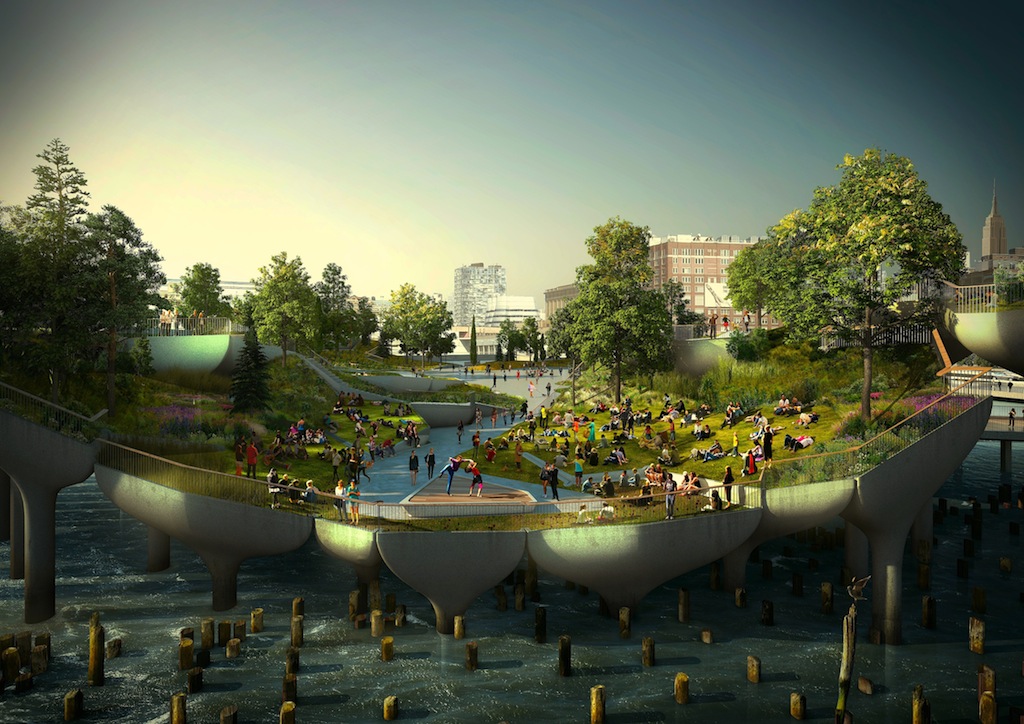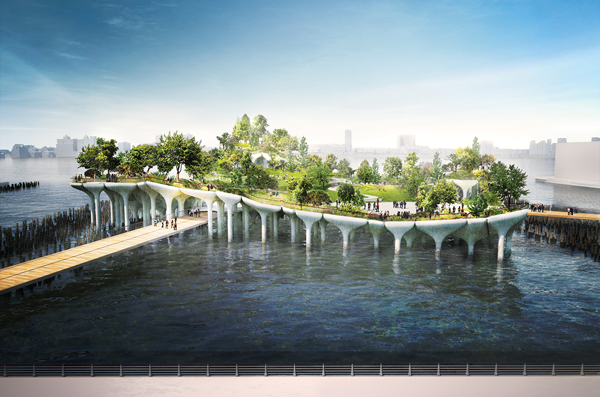Updated Wed., Dec. 3, 2014 | By now, everyone has heard about the new Pier55 plan for Hudson River Park. The high-powered husband-and-wife team of Barry Diller and Diane von Furstenberg have pledged $113 million to build a new 2.7-acre “fantasy island” for “world class” performances off of W. 13th St. The city will kick in an additional $17 million toward the construction.
In something new for Hudson River Park, the glitzy square-shaped pier would sport a rolling landscape — some might say it looks more like a rollercoaster — with three corner “peaks,” one of them towering 71 feet tall, or equal to about seven stories. The pier would sit higher than other existing piers to be safely above the floodplain in the post-Sandy era.
Because of the pier’s higher elevation, the idea was — instead of jamming it up next to the historic bulkhead — to site it out in the river, accessible by two bridge-like entry paths that slope up to reach it.
The new structure would replace the existing historic Pier 54 (where the Titanic’s survivors debarked) and be situated just north of it — hence, Pier55. There would be three performance spaces, including a 750-seat amphitheater, as well as a large central hardscape plaza surrounded by hilly grass lawns, the combo of plaza and lawns being able to seat up to 3,500 people total.

Fifty-one percent of the pier’s performances would be free or low cost. However, it’s currently not publicly known what ticket prices are envisioned for the other events. And it’s not known — again, at least not publicly — how many shows there will be during peak summer season or the whole year. The shows’ revenue would be funneled back into the pier’s programming.
According to an environmental assessment conducted for the plan, the idea is for programming to include “vocal, instrumental and other music; dramatic works, opera, theater and public readings of prose or poetry; public talks by academics, writers and public figures; performance art; dance performances; art displays, installations and exhibitions; films; and other similar events.”
Also according to the environmental assessment, crowd sizes at “peak events” would be comparable to what they would be on a rebuilt Pier 54 — around 5,000 people.
However, the report acknowledges that Pier55 could become an attraction in and of itself, and would draw an estimated 6,700 visitors on weekdays and 9,400 on weekend days. The overwhelming majority, 87 percent, would come on foot, the study says. The study uses visitation figures from the nearby 5-acre High Line park proportionally adjusted for the size difference. In short, the study states that Pier55 would get 33 percent as many daily visitors as the wildly popular High Line.
To accommodate the crowds using the new pier, utilizing $18 million in state funds, the park’s esplanade will be widened between Gansevoort Peninsula and W. 14th St., in what is being called the Pier 54 Connector Project. And a new crosswalk, federally funded, will be created across the highway at W. 13th St.
As for noise levels from Pier55 events, the study says they actually could be lower than those formerly held on Pier 54, since, in some cases, the speakers would be pointed toward the southwest, away from Manhattan.
In terms of environmental impacts, the assessment states that pile driving of fewer than 400 new “pot”-style piles for the new pier (Pier 54 originally had more than 3,500 piles) won’t negatively impact endangered migrating sturgeon or sea turtles, or 21 other species for which the Pier 54 area is considered an “essential fish habitat,” including three types of flounder, two types of mackerel, Atlantic butterfish, scup, cobia, bluefin tuna and sandbar shark, to name just a few. Most of the fish in this group are present in Hudson River Park in the larvae, juvenile and adult phases.
The fact the pier deck’s south side, in particular, would be elevated would allow sunlight to reach the water below, avoiding detrimental shading of the marine ecosystem.
Questions about whether view corridors would be blocked are also addressed in the study, which says only the view of the river down W. 13th St. would be affected — though at least the river would still be visible underneath the extra-high, raised pier.
Pier55, with its unique “noncontextual design,” wouldn’t be visible from most of the landmarked Gansevoort Historic District (Meatpacking District), the report notes.
The Hudson River Park Trust, which runs the 4-mile-long waterfront park, has been saying that the current Pier 54 is no longer viable as a main performance pier for the park. A large section of the pier dropped into the water a few years ago, and other parts of it were subsequently judged unsafe, resulting in major events now being held elsewhere in the park. Plus, because of its long, thin shape and relatively narrow entrance area, it didn’t make sense to rebuild Pier 54 in its current configuration, the Trust says.
This conveniently opened the door to the Pier55 project, for which the Trust found a very generous donor — Diller and DvF — willing to fund not only the new pier’s construction, but also its operation, maintenance and programming for the next 20 years, with an option to extend that another 10 years. A nonprofit, Pier55, Inc., helmed by Diller would operate the pier and program it with top performers.
Many will say this project is absolutely wonderful, a win-win in every sense — a beautifully landscaped and fully funded park “arts pier” that will be a stunning venue — like “Venice on the Hudson,” as von Furstenberg put it. As Assemblymember Deborah Glick told The Villager two weeks ago, “It’s a very difficult thing not to be happy about.”
At the same time, Glick has said the whole process was “shrouded in secrecy” up until recently. And she’s absolutely right. The plan was simply rolled out to the media as a virtual fait accompli.
And this does certainly seem to be a pattern with the Trust and its current leadership and staff. Of course, two years ago, stealth legislation — and it can’t be called anything other than that — was passed at the end of the state legislative session to allow the park to sell its unused development rights across the highway. Virtually no one was aware of this legislation before it was suddenly rammed through.
That was, of course, eventually followed by the “secret M.O.U,” the memorandum of understanding signed between Governor Cuomo, the Trust and Atlas Capital Group, under which Atlas conditionally committed to buying $100 million worth of development rights from Pier 40, at West Houston St., for its planned mixed-use mega-project at the St. John’s Center site. After the M.O.U. came to light — as well as the fact that a ULURP was not planned — the outcry from local politicians resulted in a commitment from Cuomo that there will at least be a ULURP for this process.
All that said…getting back to Pier55 — as the assemblymember noted, when major donors give this supersized sort of money for a project, they tend to control the design tightly, because they “don’t want to deal with the messy public process.” And, in a period when government funding for the park has declined sharply, the Trust says it needs this kind of big philanthropy. After all, 30 percent of the park still remains to be built. Then again, the sale of development rights will be a financial windfall for the park.
Nevertheless, many neighbors and park activists will cry that there has been zero public review of this project so far — even as Pier55 was being cooked up clandestinely and designed for the past two years.
Glick has also expressed concern about the idea of a nonprofit — “a private interest,” as she called it — controlling public space in Hudson River Park.
According to the Trust, Pier55 is solely a park pier, as opposed to a pier designated either fully or partially for commercial uses, and so a seven-month-long city-run ULURP (Uniform Land Use Review Procedure) process isn’t required, as would be mandated for redevelopment plans for Pier 40, for example.
State Senator Brad Hoylman, speaking at C.B. 2 last month, explained that a ULURP isn’t required because the Trust, as a government entity, is a “bizarre hybrid,” in that it’s a state-city authority.
It’s worth mentioning that before the park and the Trust were created in 1998, Glick and others did raise fears of an “unaccountable authority” running the park — and recent patterns clearly do seem to involve minimizing public input.
What is legally required, though, in the case of Pier55, at least, is a public hearing.
The Villager received a presentation of the project last month from Madelyn Wils, the Trust’s president, and theater executive Kate Horton, a member of the team that would program the pier.
The public is now getting its chance to hear and see the presentation at two public hearings.
The first of these was at the Community Board 2 Parks Committee meeting on Wed., Dec. 3, at the Village Community School, at 272 W. 10th St. In advance of the meeting, David Gruber, the board’s outgoing chairperson, told The Villager that it’s not certain, at this point, if the C.B. 2 full board will vote later this month on a resolution recommending support or denial of the project. He said he would confer with incoming C.B. 2 Chairperson Tobi Bergman on how the board will proceed.
For its part, the Trust is required, as part of a 60-day public review and comment period, to hold a public hearing on the project, since Pier55 is a “significant action” with regard to the park. This mandated hearing had previously been scheduled for Dec. 17, but has been pushed back to Mon., Jan. 12, from 5:30 p.m. to 8 p.m., at the N.Y.U. Kimmel Center, Eisner and Lubin Auditorium, 60 Washington Square South, fourth floor. The public will have an opportunity to comment on the plan at this hearing. (Photo ID is required to enter the building.)
The reason the meeting date was changed was reportedly because — due to the holiday schedule — it worked better for the community board.
Despite all the answers provided in the environmental assessment, not all will find them satisfactory.
As Glick put it, “This is an amazing gift but there are questions that still need to be answered.”
The two hearings will provide that opportunity for an extremely unique and potentially exciting project that has, however, just dropped out of thin air, as it were — or more appropriately, popped right up out of the river.


















